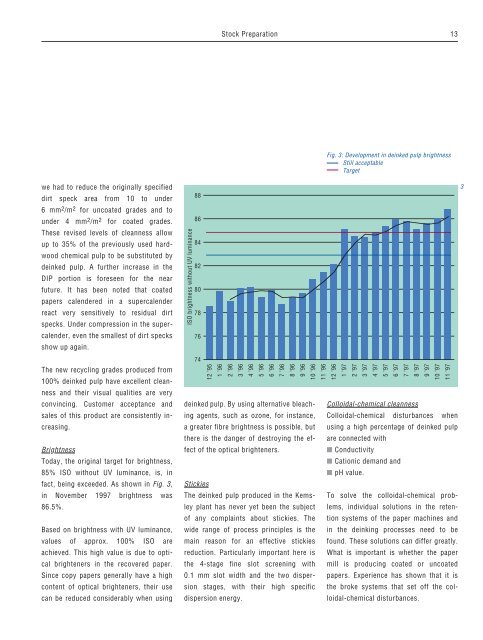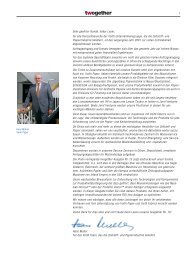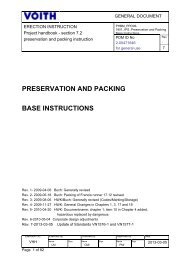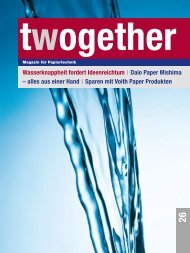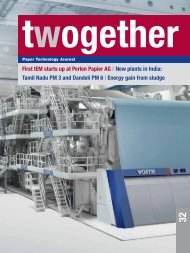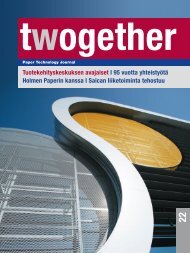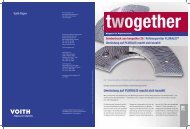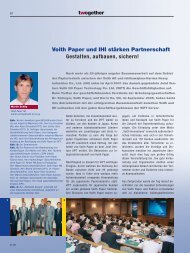Paper Technology Journal - Voith
Paper Technology Journal - Voith
Paper Technology Journal - Voith
You also want an ePaper? Increase the reach of your titles
YUMPU automatically turns print PDFs into web optimized ePapers that Google loves.
we had to reduce the originally specified<br />
dirt speck area from 10 to under<br />
6 mm2 /m2 for uncoated grades and to<br />
under 4 mm2 /m2 for coated grades.<br />
These revised levels of cleanness allow<br />
up to 35% of the previously used hardwood<br />
chemical pulp to be substituted by<br />
deinked pulp. A further increase in the<br />
DIP portion is foreseen for the near<br />
future. It has been noted that coated<br />
papers calendered in a supercalender<br />
react very sensitively to residual dirt<br />
specks. Under compression in the supercalender,<br />
even the smallest of dirt specks<br />
show up again.<br />
The new recycling grades produced from<br />
100% deinked pulp have excellent cleanness<br />
and their visual qualities are very<br />
convincing. Customer acceptance and<br />
sales of this product are consistently increasing.<br />
Brightness<br />
Today, the original target for brightness,<br />
85% ISO without UV luminance, is, in<br />
fact, being exceeded. As shown in Fig. 3,<br />
in November 1997 brightness was<br />
86.5%.<br />
Based on brightness with UV luminance,<br />
values of approx. 100% ISO are<br />
achieved. This high value is due to optical<br />
brighteners in the recovered paper.<br />
Since copy papers generally have a high<br />
content of optical brighteners, their use<br />
can be reduced considerably when using<br />
ISO brightness without UV luminance<br />
88<br />
86<br />
84<br />
82<br />
80<br />
78<br />
76<br />
74<br />
12 ’95<br />
Stock Preparation<br />
deinked pulp. By using alternative bleaching<br />
agents, such as ozone, for instance,<br />
a greater fibre brightness is possible, but<br />
there is the danger of destroying the effect<br />
of the optical brighteners.<br />
Stickies<br />
1 ’96<br />
2 ’96<br />
3 ’96<br />
4 ’96<br />
5 ’96<br />
6 ’96<br />
7 ’96<br />
8 ’96<br />
9 ’96<br />
10 ’96<br />
11 ’96<br />
The deinked pulp produced in the Kemsley<br />
plant has never yet been the subject<br />
of any complaints about stickies. The<br />
wide range of process principles is the<br />
main reason for an effective stickies<br />
reduction. Particularly important here is<br />
the 4-stage fine slot screening with<br />
0.1 mm slot width and the two dispersion<br />
stages, with their high specific<br />
dispersion energy.<br />
Fig. 3: Development in deinked pulp brightness<br />
Still acceptable<br />
Target<br />
12 ’96<br />
1 ’97<br />
2 ’97<br />
3 ’97<br />
4 ’97<br />
5 ’97<br />
6 ’97<br />
7 ’97<br />
Colloidal-chemical cleanness<br />
8 ’97<br />
9 ’97<br />
10 ’97<br />
11 ’97<br />
13<br />
Colloidal-chemical disturbances when<br />
using a high percentage of deinked pulp<br />
are connected with<br />
■ Conductivity<br />
■ Cationic demand and<br />
■ pH value.<br />
To solve the colloidal-chemical problems,<br />
individual solutions in the retention<br />
systems of the paper machines and<br />
in the deinking processes need to be<br />
found. These solutions can differ greatly.<br />
What is important is whether the paper<br />
mill is producing coated or uncoated<br />
papers. Experience has shown that it is<br />
the broke systems that set off the colloidal-chemical<br />
disturbances.<br />
3


